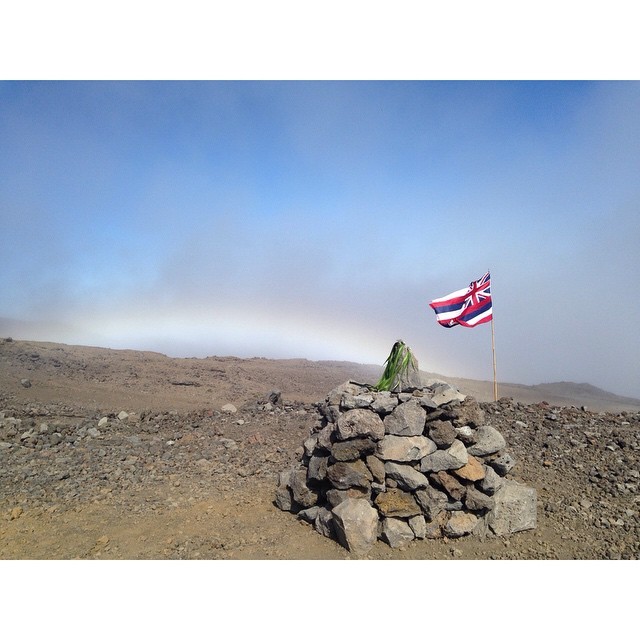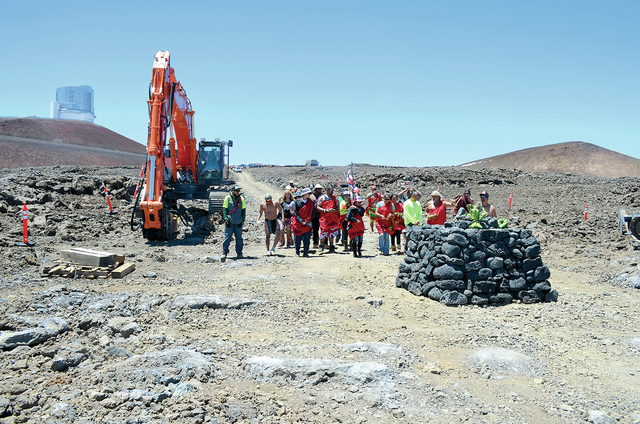The destruction of an ahu on the side of Mauna Kea Access Road has angered Thirty Meter Telescope opponents who dedicated it to the god Kane more than two months ago. ADVERTISING The destruction of an ahu on the side
The destruction of an ahu on the side of Mauna Kea Access Road has angered Thirty Meter Telescope opponents who dedicated it to the god Kane more than two months ago.
Native Hawaiian cultural practitioners discovered the stone altar, one of three built June 24 during the last confrontation between protesters and construction workers, missing Sunday when they went to the site to pray.
Lakea Trask, a TMT opponent, said the bulldozing was unnecessary and an insult to the Hawaiian culture that protesters, who see the mountain as sacred, say they are trying to protect.
“It’s a physical manifestation of our relationship with the land and with the unseen elements and forces that dwell here,” he said. “It’s not just a stack of rocks. There’s a lot of pule, there’s a lot of protocol, and a lot of love and aloha that came from thousands of people who went here to pray.”
Dan Meisenzahl, a University of Hawaii spokesman, said a Mauna Kea Support Services employee removed the ahu late August in order to access fill material used to repair a switchback that was partially eroded due to heavy rains. He said the rocks from the altar weren’t used for the road repairs.
The material, all of which is from the mountain, is staged at various points along the roadway. UH oversees the management of the 11,288-acre Mauna Kea Science Reserve that includes most of the summit road.
“He needed to get to the material so, unfortunately, he removed the ahu,” Meisenzahl said.
He said the employee didn’t intend malice by it, though he added he should have first contacted a supervisor.
“I don’t think anyone would have instructed him to remove the ahu,” Meisenzahl said.
Protesters, while following religious protocol, previously removed another two ahu built in June because they were in the roadway.
Trask said they thought they had an informal understanding with Mauna Kea rangers that the other ahu would remain since it wasn’t blocking vehicles.
The altar was named ‘Ahu o ka Uakoko after a low-lying rainbow that was seen when it was built, he said.
Meisenzahl said the employee didn’t violate any rules on the mountain because the ahu wasn’t an approved or protected structure.
The science reserve hosts 263 historic properties, including 141 shrines, in addition to 13 telescopes.
“There are no actual rules he broke,” he said. “We still would have much rather him check first.”
Asked if the employee will be disciplined, Meisenzahl said he couldn’t comment on that because it’s a personnel issue.
Trask said Hawaiians shouldn’t need to get permission from the state to build a religious shrine or have it protected.
“We do not need a permit to be kanaka maoli, to have a relationship with our akua, our ancestors, our gods,” he said.
Trask, who called the ahu removal a “hate crime,” said protesters plan to maintain a nonviolent approach called “kapu aloha.” He expects more shrines to be built.
“We’ll be taking some time to recharge, to calibrate our pule, our thoughts, and we definitely will be building more,” Trask said.
Two other ahu protesters built at the TMT site remain untouched. Construction has been on hold since late March due to protests.
The telescope, funded by an international consortium, will be the largest and most powerful observatory on the mountain.
The observatory will be capable of seeing more than 13 billion light years away and is one of three next generation telescopes that are being planned or built. Two others will be built in Chile.
It has faced strong opposition from Native Hawaiians who consider the mountain a sacred place and object to additional construction.
The project’s conservation district land use permit is being challenged in state Supreme Court.
Email Tom Callis at tcallis@hawaiitribune-herald.com.




